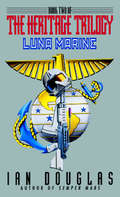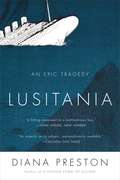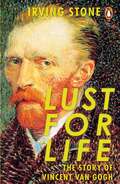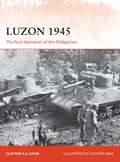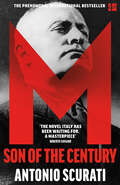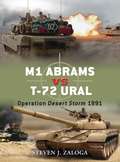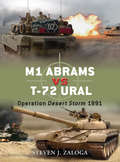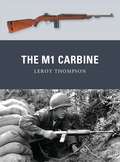- Table View
- List View
Luger: The Story of the World's Most Famous Handgun
by John WalterThe elegant but menacing silhouette of the Luger is immediately recognisable. Nearly 2 million had been manufactured by the end of the First World War, and the gun remained in production right up until the last days of the Third Reich in 1945. Author and firearms expert John Walter has produced the most comprehensive one-volume guide to the world’s most famous pistol. An engaging history, not overly complicated by technical details, this updated edition will appeal to the collectors and readers of military history alike.
Luke
by Noel StreatfeildAndrew and Freda Dawson are enjoying a happy, second marriage in the English countryside with their collective brood of three children. But their idyllic existence is shattered when Freda finds her husband dead one evening . . .It becomes apparent his death was not from natural causes and all evidence points to suicide, but there are lingering doubts about Freda’s role in the death . . . and about the possible role her precocious son Luke could have played.Carnegie Medal winning author Noel Streatfeild delves into the cracks of a seemingly perfect marriage in her interwar family novel, Luke.
Lumberjills: Britain's Forgotten Army
by Joanna FoatWhen war was declared in 1939, Britain was almost completely dependent on imported timber – but only had seven months of it stockpiled. Timber was critical to the war effort: it was needed for everything from aircraft and shipbuilding to communications and coal mining. The British timber trade was in trouble. Enter the Lumberjills. Lacking in both men and timber, the government made a choice. Reluctantly, they opened lumber work for women to apply – and apply they did. The Women’s Timber Corps had thousands of members who would prove themselves as strong and as smart as any man: they felled and crosscut trees by hand, operated sawmills, and ran whole forestry sites. They may not have been on the front line, but they fought their own battles on the home front for respect and equality. And in the midst of heavy labour and wartime, they lived a life, making firm friends and even finding soulmates. In Lumberjills, researcher Joanna Foat tells their story for the first time, and gives them the recognition they so truly deserve.
Luna Marine: Book Two Of The Heritage Trilogy (Heritage #2)
by Ian DouglasNow that the secrets of Mars have been unearthed, nation stands against nation in the brink of a catastrophic war. A war that threatens our entire existence.
The Lure of Fascism in Western Europe: German Nazis, Dutch and French Fascists, 1933-1939
by D. OrlowThis book breaks new ground by analyzing the reciprocal relationship between a fascism that had reached the power phase (Nazi Germany) and fascist movements in two neighbouring countries which were attempting to come to power in their respective societies.
Lusitania: The Cultural History of a Catastrophe
by Willi JasperA fascinating reassessment of a turning point in the First World War, revealing its role in shaping the German psyche On May 7, 1915, the Lusitania, a large British luxury liner, was sunk by a German submarine off the Irish coast. Nearly 1,200 people, including 128 American citizens, lost their lives. The sinking of a civilian passenger vessel without warning was a scandal of international scale and helped precipitate the United States’ decision to enter the conflict. It also led to the immediate vilification of Germany. Though the ship’s sinking has preoccupied historians and the general public for over a century, until now the German side of the story has been largely untold. Drawing on varied German sources, historian Willi Jasper provides a comprehensive reappraisal of the sinking and its aftermath that focuses on the German reaction and psyche. The attack on the Lusitania, he argues, was not simply an escalation of violence but signaled a new ideological, moral, and religious dimension in the struggle between German Kultur and Western civilization.
Lusitania: An Epic Tragedy
by Diana PrestonOn May 7, 1915, toward the end of her 101st eastbound crossing, from New York to Liverpool, England, R.M.S. Lusitania-pride of the Cunard Line and one of the greatest ocean liners afloat-became the target of a terrifying new weapon and a casualty of a terrible new kind of war. Sunk off the southern coast of Ireland by a torpedo fired from the German submarine U-20, she exploded and sank in eighteen minutes, taking with her some twelve hundred people, more than half of the passengers and crew. Cold-blooded, deliberate, and unprecedented in the annals of war, the sinking of the Lusitania shocked the world. It also jolted the United States out of its neutrality and hastened the nation's entry into World War I. In her riveting account of this enormous and controversial tragedy, Diana Preston recalls both a pivotal moment in history and a remarkable human drama. The story of the Lusitania is a window on the maritime world of the early twentieth century: the heyday of the luxury liner, the first days of the modern submarine, and the climax of the decades-long German-British rivalry for supremacy of the Atlantic. Above all, it is the story of the passengers and crew on that fateful voyage-a story of terror and cowardice, of self-sacrifice and heroism, of death and miraculous survival.
Lust For Life: A Novel Of Vincent Van Gogh
by Irving StoneLust for Life is the classic fictional re-telling of the incredible life of Vincent Van Gogh. “Vincent is not dead. He will never die. His love, his genius, the great beauty he has created will go on forever, enriching the world… He was a colossus… a great painter… a great philosopher… a martyr to his love of art. “Walking down the streets of Paris the young Vincent Van Gogh didn’t feel like he belonged. Battling poverty, repeated heartbreak and familial obligation, Van Gogh was a man plagued by his own creative urge but with no outlet to express it. Until the day he picked up a paintbrush.Written with raw insight and emotion, follow the artist through his tormented life, struggling against critical discouragement and mental turmoil and bare witness to his creative journey from a struggling artist to one of the world’s most celebrated artists.
Lützen: Great Battles (Great Battles)
by Peter H. WilsonThe Thirty Years' War (1618-48) was Europe's most destructive conflict prior to the two world wars. Two of European history's greatest generals faced each other at Lützen in November 1632, mid-way through this terrible war. Neither achieved his objective. Albrecht von Wallenstein withdrew his battered imperial army at nightfall, unaware that his opponent, King Gustavus Adolphus of Sweden, had died a few hours earlier. The indecisive military outcome found an immediate echo in image and print, and became the object of political and historical disputes. Swedish propaganda swiftly fostered the lasting image of the king's sacrifice for the Protestant cause against the spectre of Catholic Habsburg 'universal monarchy'. The standard assumption that the king had 'met his death in the hour of victory' became integral to how Gustavus Adolphus's contribution to modern warfare has been remembered, even celebrated, while the study of Lützen's wider legacy shows how such events are constantly rewritten as elements of propaganda, religious and national identity, and professional military culture. The battle's religious and political associations also led to its adoption as a symbol by those advocating German unification under Prussian leadership. The battlefield remains a place of pilgrimage to this day and a site for the celebration of Protestant German and Nordic culture. This book is the first to combine analysis of the battle itself with an assessment of its cultural, political and military legacy, and the first to incorporate recent archaeological research within a reappraisal of the events and their significance. It challenges the accepted view that Lützen is a milestone in military development, arguing instead that its impact was more significant on the cultural and political level.
Lützen: Great Battles (Great Battles)
by Peter H. WilsonThe Thirty Years' War (1618-48) was Europe's most destructive conflict prior to the two world wars. Two of European history's greatest generals faced each other at Lützen in November 1632, mid-way through this terrible war. Neither achieved his objective. Albrecht von Wallenstein withdrew his battered imperial army at nightfall, unaware that his opponent, King Gustavus Adolphus of Sweden, had died a few hours earlier. The indecisive military outcome found an immediate echo in image and print, and became the object of political and historical disputes. Swedish propaganda swiftly fostered the lasting image of the king's sacrifice for the Protestant cause against the spectre of Catholic Habsburg 'universal monarchy'. The standard assumption that the king had 'met his death in the hour of victory' became integral to how Gustavus Adolphus's contribution to modern warfare has been remembered, even celebrated, while the study of Lützen's wider legacy shows how such events are constantly rewritten as elements of propaganda, religious and national identity, and professional military culture. The battle's religious and political associations also led to its adoption as a symbol by those advocating German unification under Prussian leadership. The battlefield remains a place of pilgrimage to this day and a site for the celebration of Protestant German and Nordic culture. This book is the first to combine analysis of the battle itself with an assessment of its cultural, political and military legacy, and the first to incorporate recent archaeological research within a reappraisal of the events and their significance. It challenges the accepted view that Lützen is a milestone in military development, arguing instead that its impact was more significant on the cultural and political level.
Lützen & Bautzen 1813: The Turning Point (Campaign)
by Christa Hook Peter HofschröerFollowing the disastrous Russian campaign of 1812, Napoleon found himself facing a new coalition of his old enemies. With incredible speed he raised an army of 200,000 men and marched to join the remnants of the old Grande Armee in Germany. However, he no longer faced the brittle enemies of 1805 and 1806 and at Lützen on 2 May the inexperience of his new army began to show. Faulty reconnaissance by raw cavalry allowed Ney's Corps to be surprised by Wittgenstein's Russians. This book describes the last realistic chance Napoleon had to regain his empire by defeating the allies in Germany before Austria stirred and the tide turned even more against him.
Lützen & Bautzen 1813: The Turning Point (Campaign)
by Christa Hook Peter HofschröerFollowing the disastrous Russian campaign of 1812, Napoleon found himself facing a new coalition of his old enemies. With incredible speed he raised an army of 200,000 men and marched to join the remnants of the old Grande Armee in Germany. However, he no longer faced the brittle enemies of 1805 and 1806 and at Lützen on 2 May the inexperience of his new army began to show. Faulty reconnaissance by raw cavalry allowed Ney's Corps to be surprised by Wittgenstein's Russians. This book describes the last realistic chance Napoleon had to regain his empire by defeating the allies in Germany before Austria stirred and the tide turned even more against him.
'Luxury' Fleet: The Imperial German Navy 1888-1918 (Routledge Library Editions: The First World War)
by Holger H. HerwigOriginally published in 1980 ‘Luxury’ Fleet (the phrase was Winston Churchill’s) was the first history of the Imperial German navy from 1888 to 1918. After tracing the historical background to German naval ambitions, the first two sections of the book analyse Admiral Tirpitz’s programme of building a battle fleet strong enough to engage the Royal Navy in the North Sea. The author shows the fleet in its European setting and describes the warships and the attitudes of the officer corps and seamen. The final section of the book discusses the tactical deployment of the German fleet during the First World War, both in home waters and overseas; and it weighs the balance between those who supported fleet actions in preference to those who favoured cruiser and submarine warfare.
'Luxury' Fleet: The Imperial German Navy 1888-1918 (Routledge Library Editions: The First World War)
by Holger H. HerwigOriginally published in 1980 ‘Luxury’ Fleet (the phrase was Winston Churchill’s) was the first history of the Imperial German navy from 1888 to 1918. After tracing the historical background to German naval ambitions, the first two sections of the book analyse Admiral Tirpitz’s programme of building a battle fleet strong enough to engage the Royal Navy in the North Sea. The author shows the fleet in its European setting and describes the warships and the attitudes of the officer corps and seamen. The final section of the book discusses the tactical deployment of the German fleet during the First World War, both in home waters and overseas; and it weighs the balance between those who supported fleet actions in preference to those who favoured cruiser and submarine warfare.
Luzon 1945: The final liberation of the Philippines (Campaign #306)
by Clayton Chun Giuseppe RavaDriven from the Philippines in 1942, General Douglas MacArthur returned three years later to force the Japanese off of its main island of Luzon. Containing the capital of Manila, vital natural resources as well as thousands of Allied prisoners of war, the triumph at Luzon would be a vital step on the road to victory as the Americans continued to island-hop their way towards the Japanese home islands. This new study details one of the hardest-fought campaigns of the Pacific War with Japanese fatalities alone on Luzon topping 200,000. Emphasizing the differences in Japanese and American strategy, and detailing the combat operations of the campaign, this volume tells the story of how MacArthur kept his promise to return and liberate the Philippines.
Luzon 1945: The final liberation of the Philippines (Campaign #306)
by Clayton Chun Giuseppe RavaDriven from the Philippines in 1942, General Douglas MacArthur returned three years later to force the Japanese off of its main island of Luzon. Containing the capital of Manila, vital natural resources as well as thousands of Allied prisoners of war, the triumph at Luzon would be a vital step on the road to victory as the Americans continued to island-hop their way towards the Japanese home islands. This new study details one of the hardest-fought campaigns of the Pacific War with Japanese fatalities alone on Luzon topping 200,000. Emphasizing the differences in Japanese and American strategy, and detailing the combat operations of the campaign, this volume tells the story of how MacArthur kept his promise to return and liberate the Philippines.
Lyndon B. Johnson and the Politics of Arms Sales to Israel: In the Shadow of the Hawk
by Abraham Ben-ZviLyndon B. Johnson and the Politics of Arms Sales to Israel seeks to reconstruct and elucidate the processes behind the decisions made by the Johnson Administration during the years 1965-68 to sell Israel M-48 tanks, A-4 Skyhawk planes and F-4 Phantom planes. This examination is based on a distinction between three factions which competed for influe
Lyndon B. Johnson and the Politics of Arms Sales to Israel: In the Shadow of the Hawk (Israeli History, Politics And Society Ser.)
by Abraham Ben-ZviLyndon B. Johnson and the Politics of Arms Sales to Israel seeks to reconstruct and elucidate the processes behind the decisions made by the Johnson Administration during the years 1965-68 to sell Israel M-48 tanks, A-4 Skyhawk planes and F-4 Phantom planes. This examination is based on a distinction between three factions which competed for influe
M: MI5's First Spymaster
by Andrew CookThis is the amazing true story of the real 'M', William Melville, MI5's founding father and the inspiration for Ian Flemings's character in "James Bond". Melville was one of the most influential counter-espionage figures of the twentieth century. From a tiny outfit based in Victoria Street, London, the counter-intelligence organisation that Melville lobbied the Government to create is today a household name and one of the world's leading intelligence agencies. He was perfect for the job, a velvet-gloved hardman who had run Scotland Yard's Special Branch and whose career had already taken in some of London's great crime dramas including the Jack the Ripper Investigation, countering Irish Republican terrorism, assassination attempts on Queen Victoria and anarchist bomb plots. Now, with the help of recently declassified records, family material and documents that have still not officially seen the light of day, the story of his Secret Service career - including the breaking of German spy rings prior to the outbreak of World War I - can finally be told.
M: Maxwell Knight, MI5's Greatest Spymaster
by Henry Hemming*** The Sunday Times bestseller ***'Vividly imagined and prodigiously researched' Helen Davies, Sunday Times, Books of the Year 'Such a rewarding read' John Preston, Daily Mail, Books of the Year'This odd, secretive man is brought to life', Robbie Millen, The Times, Books of the YearMaxwell Knight was a paradox. A jazz obsessive and nature enthusiast (he is the author of the definitive work on how to look after a gorilla), he is seen today as one of MI5's greatest spymasters, a man who did more than any other to break up British fascism during the Second World War – in spite of having once belonged to the British Fascisti himself. He was known to his agents and colleagues simply as M, and was rumoured to be part of the inspiration for the character M in the James Bond series.Knight became a legendary spymaster despite an almost total lack of qualifications. What set him apart from his peers was a mercurial ability to transform almost anyone into a fearless secret agent. He was the first in MI5 to grasp the potential of training female agents.M is about more than just one man however. In its pages, Hemming reveals for the first time in print the names and stories of seven men and women recruited by Knight, on behalf of MI5, and then asked to infiltrate the most dangerous political organizations in Britain at that time. Until now, their identities have been kept secret outside MI5. Drawn from every walk of life, they led double lives—often at great personal cost—in order to protect the country they loved. With the publication of this book, it will be possible at last to celebrate the lives of these courageous, selfless individuals.Drawing on declassified documents, private family archives and interviews with retired MI5 officers as well as the families of MI5 agents, M reveals not just the shadowy world of espionage but a brilliant, enigmatic man at its centre.
M.: Son Of The Century
by Antonio ScuratiAn International Bestseller M. is a startling look into the fascist mindset, a portrait of unrelenting determination, and an impeccable work of historical fiction.
M1 Abrams vs T-72 Ural: Operation Desert Storm 1991 (Duel #18)
by Steven J. Zaloga Jim LaurierThe Gulf War bore witness to a number of deadly encounters between these two great adversaries. Heavily armoured, highly mobile and capable of killing at over 2500m the M1 Abrams is, to this day, a veritable fighting machine. Superior to both Iraq's Soviet era T-55 and T-62 tanks, nearly all sources claim that no Abrams tank has ever been destroyed by enemy fire. Despite entering service in 1980, the M1 Abrams remained untested in combat until the Gulf War in 1991, where it was to be confronted by its archenemy the Iraqi-assembled Soviet-designed T-72. Entering production in 1971, the T-72 arguably outstripped its contemporaries in a balance of mobility, protection and firepower. By the time of Operation Desert Storm, however, the tables had turned and the tank suffered due to low quality ammunition and poorly trained crews. In this fascinating study, Steven Zaloga pits these two great fighting machines against one another, plotting the development of the Cold War until both tanks met in combat in the deserts of Iraq and Kuwait.
M1 Abrams vs T-72 Ural: Operation Desert Storm 1991 (Duel #18)
by Steven J. Zaloga Jim LaurierThe Gulf War bore witness to a number of deadly encounters between these two great adversaries. Heavily armoured, highly mobile and capable of killing at over 2500m the M1 Abrams is, to this day, a veritable fighting machine. Superior to both Iraq's Soviet era T-55 and T-62 tanks, nearly all sources claim that no Abrams tank has ever been destroyed by enemy fire. Despite entering service in 1980, the M1 Abrams remained untested in combat until the Gulf War in 1991, where it was to be confronted by its archenemy the Iraqi-assembled Soviet-designed T-72. Entering production in 1971, the T-72 arguably outstripped its contemporaries in a balance of mobility, protection and firepower. By the time of Operation Desert Storm, however, the tables had turned and the tank suffered due to low quality ammunition and poorly trained crews. In this fascinating study, Steven Zaloga pits these two great fighting machines against one another, plotting the development of the Cold War until both tanks met in combat in the deserts of Iraq and Kuwait.
The M1 Carbine (Weapon)
by Peter Dennis Leroy Thompson Alan GillilandIn 1938 the US Chief of Infantry requested that the Ordnance Department develop a carbine to be used by service and support troops, artillerymen, machine-gun crews, tankers, mortar crews and other troops not needing the power of the M1 Garand rifle. The development of this new weapon was given an added impetus by Germany's successful use of airborne and glider troops early on in World War II. This caused a fear amongst US officers that troops normally considered 'behind the lines' personnel might have to fight elite German troops and would therefore require a more effective weapon than their standard pistols. The resulting M1 Carbine was a not a shortened version of the standard service rifle but instead a brand-new design chambering a new cartridge. Eventually numerous manufacturers would combine to produce over six million M1 Carbines before the end of the war. This book charts the complete story of the weapon, from its design, to its operational history and its impact upon warfare.
The M1 Carbine (Weapon #13)
by Peter Dennis Leroy Thompson Alan GillilandIn 1938 the US Chief of Infantry requested that the Ordnance Department develop a carbine to be used by service and support troops, artillerymen, machine-gun crews, tankers, mortar crews and other troops not needing the power of the M1 Garand rifle. The development of this new weapon was given an added impetus by Germany's successful use of airborne and glider troops early on in World War II. This caused a fear amongst US officers that troops normally considered 'behind the lines' personnel might have to fight elite German troops and would therefore require a more effective weapon than their standard pistols. The resulting M1 Carbine was a not a shortened version of the standard service rifle but instead a brand-new design chambering a new cartridge. Eventually numerous manufacturers would combine to produce over six million M1 Carbines before the end of the war. This book charts the complete story of the weapon, from its design, to its operational history and its impact upon warfare.



